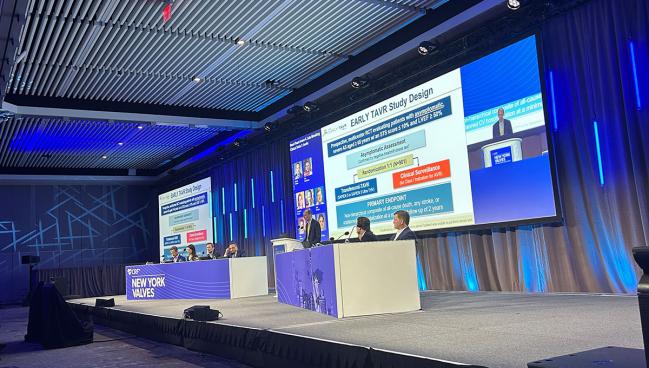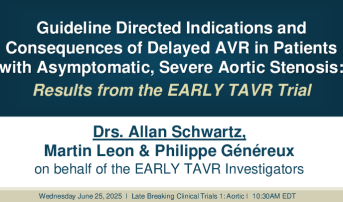Prompt TAVI Benefits Asymptomatic AS Patients Regardless of Guideline Indication
In EARLY TAVR, intervention improved outcomes over waiting in patients with class II or no indications for AVR consideration.

NEW YORK, NY—Performing TAVI promptly in asymptomatic patients with severe aortic stenosis improves outcomes over clinical surveillance irrespective of whether they have a class II guideline indication for aortic valve replacement (AVR), or no indication at all based on the current recommendations, an analysis of the EARLY TAVR trial indicates.
Though patients with a class IIa or IIb guideline indication for consideration of AVR had a greater risk of poor outcomes than those without a guideline indication, immediate TAVI reduced the risk of death, stroke, or heart failure (HF) hospitalization, and other composite endpoints, across all three groups, Allan Schwartz, MD (NewYork-Presbyterian/Columbia University Irving Medical Center, New York, NY), reported here at New York Valves 2025.
Among the patients randomized to clinical surveillance, about half of those with a class IIa or IIb indication, and more than one-third of those with no guideline indication, eventually underwent AVR after developing an acute valve syndrome.
Considering the positive overall results of EARLY TAVR, the low procedural risk with TAVI, the rapid progression to AVR under careful surveillance, and the challenges with detecting symptoms and treating patients swiftly in everyday practice, “the EARLY TAVR trial does support early intervention as the preferred strategy independent of the guideline indication,” Schwartz concluded.
Lead discussant for the study, Patrick O’Gara, MD (Brigham and Women’s Hospital, Boston, MA), pointed out that this substudy was not prespecified so it should be considered “hypothesis generating.”
Still, one of the take-home messages, O’Gara said, is that “we shouldn’t rely on the development of what are cited as class II recommendations to make a treatment decision. There’s no significant interaction between the presence or absence of these particular indications and the benefit and risk of TAVR under these circumstances.”
To TCTMD, Tsuyoshi Kaneko, MD (Washington University School of Medicine, St. Louis, MO), said the main EARLY TAVR results, and subsequent subanalyses, are “changing the way that we’re thinking” about treating these patients.
The issue, however, is not black and white, he commented. “All asymptomatic patients need to have TAVR or SAVR? That is a wrong message,” he said. “For us to figure out that gray zone, I think we need more evidence and some of these subgroup analyses will help us.”
AVR Indications in EARLY TAVR
EARLY TAVR included patients with asymptomatic severe aortic stenosis who were at least 65 years old, had an STS score of 10% or lower, and an LVEF of 50% or higher. They were randomized to immediate transfemoral TAVI with a Sapien or Sapien 3 Ultra valve (Edwards Lifesciences) or to clinical surveillance to monitor for development of a class I indication for AVR. As reported previously, prompt TAVI reduced the risk of all-cause death, any stroke, or unplanned cardiovascular hospitalization through a minimum follow-up of 2 years (HR 0.50; 95% CI 0.40-0.63). There was also a lower risk of death, stroke, or HF hospitalization (HR 0.60; 95% CI 0.44-0.83).
The findings supported an expansion of the indication for the balloon-expandable Sapien 3 platform by the US Food and Drug Administration to include treatment of asymptomatic patients.
The purpose of the current secondary analysis, Schwartz said, was to examine the prevalence and impact of guideline indications for AVR in the trial, which excluded patients who had a class I indication for an intervention.
The 2020 US valvular heart disease guideline contains several class IIa recommendations identifying factors that make AVR reasonable in asymptomatic patients: decreased exercise tolerance or a drop in systolic blood pressure ≥ 10 mm Hg, aortic velocity ≥ 5 m/s, NT-proBNP levels more than three times normal, or an increase in aortic velocity ≥ 0.3 m/s per year. There is also a class IIb recommendation stating that AVR may be considered when there is a progressive decrease in LVEF to less than 60%. Schwartz noted that the guidelines indicate a preference for SAVR over TAVI for patients with class II indications.
Of the 901 patients in EARLY TAVR, 70.6% had no indications for consideration of AVR, 22.4% had a class IIa indication, and 7.0% had a class IIb indication.
Compared with patients with no guideline indication, the class II patients had slightly higher STS risk scores, higher NT-proBNP levels, and a greater rate of atrial fibrillation. Class IIa patients had more-severe aortic stenosis, with higher gradients on echocardiography, and class IIb patients had lower ejection fractions and more strain.
Rates of death, stroke, of HF hospitalization through a median follow-up of 3.8 years varied across the three indications, from a low of 21.0% in patients with no indication to 26.0% and 32.9% in patients with class IIb and class IIa indications.
The impact of early TAVI versus clinical surveillance did not significantly differ across these three groups for a variety of composite clinical outcomes (P = NS for all interactions).
Within the surveillance arm, patients with class II indications at randomization went on to receive AVR sooner than patients without a guideline indication, although conversion was rapid in all three groups. By 2 years, 68% to 83% of patients in the surveillance arm had undergone delayed AVR.
At the time of delayed AVR, roughly half of patients with class II indications, and 35.2% of those with no guideline indication, had developed an acute valve syndrome. Schwartz noted, “These patients are being followed extremely carefully every 6 to 12 months per the guidelines.”
Clinical presentation included a progressive valve syndrome in 62.9% of patients with no guideline indication, 45.7% of class IIb patients, and 50.6% of class IIa patients. A small number of patients presented with no symptoms at the time of delayed AVR.
At 2 years, clinical outcomes were better in patients who had undergone immediate versus delayed AVR, with a rate of death, stroke, or HF hospitalization of 6.8% in patients who received prompt TAVI, 8.2% in those undergoing delayed AVR with a progressive valve syndrome, and 14.9% in those undergoing delayed AVR with an acute valve syndrome.
Challenging the Guidelines
Kaneko said that the EARLY TAVR analyses that have been coming out are moving the field of AVR in new directions, noting that this analysis, in particular, is “challenging the guidelines.”
By showing that early intervention has a beneficial effect in all three groups of patients, “it almost tells you that even if you have the guideline indications, it’s already too late.” That provides more impetus, he added, toward “treating these aortic stenosis patients earlier.”
It’ll be interesting to see how all the data will be incorporated into the next iteration of the valve disease guidelines, and “I think it’ll change a lot of the ways that we’re thinking at the moment,” Kaneko said.
As for whether these findings inform the choice between SAVR and TAVI in these types of patients, Kaneko, a cardiothoracic surgeon, said while they add data to the TAVI side, the decision still comes down to the individual characteristics of the patient.
When considering an early intervention, “I think you have to do TAVR for high-risk patients because in order for those early-intervention patients to get benefits, they cannot have a complication or mortality from the procedure itself. The procedural risk has to be lower than the waiting risk,” he said.
For low-risk patients, “that’s where the discussion really becomes interesting,” Kaneko continued. “Do you do surgery, or do you do TAVR? I think this data shows that TAVR has good outcomes in asymptomatic patients with class II indications, in addition to SAVR evidence that is already out there. So, I think this will involve a lot of heart team discussion for these lower-risk patients.”
How to decide whether an asymptomatic patient requires AVR, or will do fine with surveillance, remains a tricky issue. “I think it’s the unpredictability that came out in this trial,” Schwartz said.
Panelist Brian Lindman, MD (Vanderbilt University Medical Center, Nashville, TN), pointed out that it’s been difficult to identify patients who are likely to benefit more from intervention using various characteristics, including biomarkers, age, and degree of cardiac damage.
“I think it now needs to flip the script and say the default should be that you intervene promptly with some potential exceptions,” like in the presence of high-risk anatomy or marked frailty, he said. “We need to flip our paradigm from looking for reasons to intervene to considering reasons maybe not to intervene promptly.”
Todd Neale is the Associate News Editor for TCTMD and a Senior Medical Journalist. He got his start in journalism at …
Read Full BioSources
Schwartz A. Guideline-directed indications and consequences of delayed AVR in patients with asymptomatic, severe aortic stenosis: results from the EARLY TAVR trial. Presented at: New York Valves 2025. June 25, 2025. New York, NY.
Disclosures
- EARLY TAVR was sponsored by Edwards Lifesciences.
- Schwartz reports being a principal investigator for the trial.






Comments